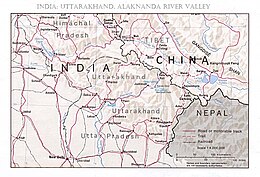Significant floods
Australia
Extreme rainfall on the east coast of Australia beginning on 18 March 2021 led to widespread flooding in New South Wales, affecting regions from the North Coast to the Sydney metropolitan area in the south. Suburbs of Sydney experienced the worst flooding in 60 years, [2] and the events were described by NSW Premier Gladys Berejiklian as "one in 100-year" flooding. Far-southeast communities in Queensland were also affected by flooding and heavy rainfall, though to a lesser extent than those in New South Wales.
The Australian government declared many parts of the east coast a natural disaster zone after the flooding rains forced 18,000 people to evacuate, in addition to over 1,000 flood rescues. [3] Described as a "prolonged event" by Berejiklian and "dangerous and threatening" by the Bureau of Meteorology, the floods extended from the coastal towns of Taree and Kempsey on Thursday, 18 March, to the populated suburbs of western Sydney by Friday and Saturday. [4]
The floods occurred less than 18 months after Australia was affected by the Black Summer bushfires, impacting many towns still recovering from the previous disaster. [5]China

Europe

In July 2021, several European countries were affected by severe floods. Some were catastrophic, causing deaths and widespread damage. The floods started in the United Kingdom as flash floods causing some property damage and inconvenience. Later floods affected several river basins across Europe including Austria, Belgium, Croatia, Germany, Italy, Luxembourg, the Netherlands, and Switzerland. [19] At least 243 people died in the floods, including 196 in Germany, [20] 43 in Belgium, [21] two in Romania, [22] one in Italy [23] and one in Austria. [24]
Belgian Minister of Home Affairs Annelies Verlinden described the events as "one of the greatest natural disasters our country has ever known." German minister-president Malu Dreyer of the Rhineland-Palatinate state called the floods "devastating". In addition to the confirmed fatalities, the flooding led to widespread power outages, forced evacuations and damage to infrastructure and agriculture in the affected areas. The damage to infrastructure was especially severe in Belgium and Germany. [25] The floods are estimated to have cost up to €2.55 billion (US$3 billion) in insured losses, with the total damage costs being much higher, [26] [27] at a minimum of €10 billion (US$11.8 billion). [28] In the aftermath, scientists, activists and reporters all highlighted the connection to global trends in extreme weather, especially more frequent heavy rainfall caused by climate change. [29]India
Uttarakhand

South India
Malaysia
20–21
21–22

On 16 December 2021, a tropical depression made landfall on the eastern coast of Peninsular Malaysia, bringing torrential downpours throughout the peninsula for three days. The resulting floods affected eight states across the peninsula, and left at least 54 dead and 2 missing. [39] [40] During its furthest extent, it caused the concurrent displacement of more than 71,000 residents, [41] and have affected over 125,000 people overall. [42]
Declared by government officials as a "once in a century" disaster, [43] it is the worst flood in the country in terms of displaced residents since the 2014–2015 Malaysia floods. [44] [45] [46] It has also been historically compared with the 1971 Kuala Lumpur floods. [47] It is the deadliest tropical cyclone-related disaster to hit Malaysia since Tropical Storm Greg of 1996, which killed 238 people and left 102 more missing. [48]
Record-high precipitations were measured at weather stations at Selangor and Kuala Lumpur. [49] Widespread damages were reported in the states of Selangor and Pahang, especially the district of Hulu Langat and the city of Shah Alam. The Malaysian government has suffered criticism over its delayed response and apathy towards the disaster. [50] Scientists, climate activists, and the media have largely made connections of this disaster as an example of extreme weather attributed to climate change. [51]North America
Hawaii
Pacific Northwest
The 2021 Pacific Northwest floods were a series of floods that affected British Columbia, Canada, and parts of neighboring Washington state in the United States. The flooding and numerous mass wasting events were caused by a Pineapple Express, a type of atmospheric river, which brought heavy rain to parts of southern British Columbia and northwestern United States. The natural disaster prompted a state of emergency for the province of British Columbia. [55]
Of particular concern in southern British Columbia was the severe short-term and long-term disruption of the transportation corridor linking the coastal city of Vancouver, Canada's largest port, to the Fraser Valley, the rest of British Columbia and the rest of Canada. The Fraser Valley, which is heavily populated, is responsible for most of the agricultural production in the province, with limited ability to feed livestock in the absence of rail service. [56] The Fraser Valley was particularly hard hit, as all major routes westward to Vancouver and eastward toward Alberta were impacted. Alternative routes into northern BC and southbound into Washington state are limited by the mountainous topography. The heavily used rail links of the Canadian National Railway (CN) and Canadian Pacific Railway (CP) were both disrupted, as well as all highways that connect the Lower Mainland with the rest of the province. [57]
The British Columbia Minister of Public Safety, Mike Farnworth, issued a statement that the military deployment ended on December 17 after a month of aid. Conditions had improved enough for the reconstruction be managed by contractors, non-governmental organizations and a dedicated contingent from the region's wildland fire management service. [58]
On December 10, the Insurance Bureau of Canada announced that the flooding cost at least $CDN 450 million in insured damage, making it the costliest natural disaster in British Columbia history. However, this amount did not include damage to infrastructure and other uninsured property. In particular, in the Sumas Prairie of the Abbotsford area, more than 600,000 farm animals perished in the floods. [59] The reinsurer Aon issued a statement on December 17, 2021 claiming that the economic damage would amount to more than US$ 2 billion. [60] According to the annual report of the NGO Christian Aid, issued December 26, the damages could amount up to US$ 7.5 billion. [61]
















